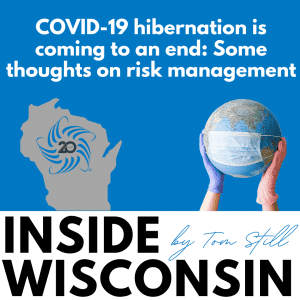By Tom Still
 MADISON, Wis. – Sooner or later, we must all emerge.
MADISON, Wis. – Sooner or later, we must all emerge.
You probably understand that, deep down, but there may be a part of you that has become so emersed in the COVID-19 swing of things that you’re nervous – even afraid – of a return to “normal.”
Alas, the Great Readjustment is coming. Like a groundhog on Feb. 2, we can duck back into the hole for a while longer, but we’ll stick our heads out for good with a few more turns of the calendar.
Some states are lifting all mask rules, in part because their citizens are fed up; in part because the elected leaders in those states never believed in any mandates. That could yet come back to haunt them if variants take off.
Then again, there’s strong evidence in Wisconsin and elsewhere that more people wearing masks combined with the early wave of vaccinations is stopping the spread of a disease that has taken more than 500,000 American lives. Concurrently, worries of vaccine “side effects” are waning as society looks past wild predictions of people dropping dead in their tracks or being turned into microchip-controlled zombies.
And yet, we all wonder what the post-pandemic world holds for us.
- For men who have gone a year without wearing a tie, let alone a respectable collared shirt, what will be the “new normal” dress code? Will it require pants?
- Women who haven’t gone through the agony of matching tops and bottoms for months may find themselves getting reacquainted with their closets. Or emptying them.
- Will we remember how to eat a lunch while sitting across the table from an actual person or people? Better yet, will there be enough restaurants left to patronize?
- Will there be “office politics” when there’s not a physical office?
- Will we renew centuries of hand-shake tradition or continue the awkward new custom of elbow-bumping and spilling whatever drink is being carried at the time?
Some of us will miss a few aspects of life during COVID-19, an experience which may drive enduring trends.
We’ve gone from complaining about Zoom burnout to recognizing we’re saving time, energy and money by not hustling to physical meetings that may be marginally important.
There’s no substitute for physical meetups in many cases, of course, but COVID may have taught us which ones to resume and which ones can likely stay virtual. A hybrid future is likely.
The economy continues to transform itself in ways hardly imaginable a year ago. Innovative young companies are providing solutions to keep people safe, fed, entertained, informed, well-stocked with essentials and much more.
Some things won’t be missed, at least, by me. Most of them revolve around our inability to assess and manage risks.
On the one end were people who believed wearing a mask was a commie plot and a threat to their personal liberties. Great … don’t wear a mask, but don’t wonder why there’s no room at the hospital when you get a serious case of coronavirus.
On the other end are those who profess to believe in the “science” surrounding COVID-19 but whose practices tend to shame people who are anything less than manic in their precautions.
Faye Flam, an award-winning science writer, touched on that phenomenon in a recent column for Bloomberg news. She noted there has never been any evidence that touching packages in a grocery store or unmasked bikers, runners and walkers outdoors carried more than an extremely low possibility of COVID-19 transmissions.
“Throughout the pandemic, there’s been a tendency to play up unlikely risks, and not to talk enough about uncertainty and probabilities,” Flam wrote. “The risk of getting COVID-19 from groceries or mail or monkey bars always was a guess.”
And yet, those kinds of over-reactions have turned many Americans against the real dangers of the pandemic by attempting to persuade them every risk is a big one. That is simply not so. For people who harbor doubts about COVID-19 precautions, the reaction is to dismiss the manics as lacking common sense.
“Some might feel magnifying small risks is erring on the side of caution,” Flam wrote. “But if freaking people out about small things is distracting from the risks that have led to most of the 500,000 deaths, then perhaps true caution would instead dictate erring as little as possible.”
We’re all coming back eventually, to one degree or another. Try to separate real risks from risks so small as to not fret over. It will make your “Groundhog Day” re-emergence go better.
Still is president of the Wisconsin Technology Council. He can be reached at tstill@wisconsintechnologycouncil.com.


